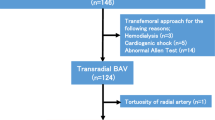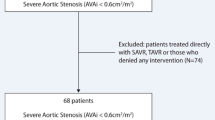Summary
Percutaneous transluminal valvuloplasty (PTV) was performed in 24 patients (aged 67–86 years, mean: 76±5.7 years) with calcific aortic stenosis and high operative risk. The gradient between maximal left ventricular and aortic pressures (peak-to-peak gradient, PPPG) could be reduced by 52% from 73±21 to 34±12 mmHg (p<0.001). Peak pressure gradient (PPG), as assessed by continuous wave Doppler, could be reduced from 80±28 to 58±21 mmHg (p<0.001). Aortic valve area (AVA) as determined by Doppler and two dimensional echocardiography increased significantly from 0.39±0.14 to 0.61±0.3 cm2 (p<0.05). Clinical symptoms were found to be improved in 5 of 8 patients with impaired ejection fraction and in 11 of 16 patients with normal ejection fraction during the first week after PTV. Complications due to the procedure were surgical revision of femoral artery puncture site in one patient and hemodynamic relevant pericardial effusion in another patient. Transmitral early (E) and late (L) diastolic filling integrals were measured by pulsed Doppler: the ratio E/L decreased significantly after PTV from 0.9±0.5 to 0.63±0.31 (p<0.03) indicating further reduction of left ventricular early diastolic filling. Ejection fraction, stroke volume and cardiac output did not significantly change immediately after PTV.
The results indicate, that PTV can successfully reduce aortic pressure gradients and improve symptoms in patients with calcific aortic stenosis and high operative risk. Doppler echocardiography provides an adequate method to noninvasively evaluate the initial outcome of PTV and seems valuable for the assessment of long term results.
Similar content being viewed by others
Abbreviations
- AKE:
-
prothetischer Aortenklappenersatz
- AoP:
-
maximaler systolischer Aortendruck
- AVA:
-
Aortenklappenöffnungsfläche
- E:
-
Integral frühdiastolischer Füllungsgeschwindigkeiten
- EF:
-
Ejektionsfraktion
- HR:
-
Herzfrequenz
- HZV:
-
Herzzeitvolumen
- L:
-
Integral spätdiastolischer Füllungsgeschwindigkeiten
- LVP:
-
maximaler systolischer linksventrikulärer Druck
- NYHA:
-
New York Heart Association
- PPG:
-
peak pressure gradient
- PPPG:
-
peak-to-peak pressure gradient
- PTV:
-
Perkutane transmfemorale Valvuloplastie
- SEP:
-
Systolische Ejektionsperiode
- SV:
-
Schlagvolumen
Literatur
Block PC, Palacios IF (1987) Comparison of hemodynamic results of anterograde versus retrograde percutaneous balloon aortic valvuloplasty. Am J Cardiol 60:659–662
Bussmann WD, Sievert H, Reifart N (1984) Perkutane Pulmonalklappensprengung. Dtsch med Wschr 109:1106–1108
Cribier A, Saoudi N, Berland J, Savin T, Rocha P, Letac B (1986) Percutaneous transluminal valvuloplasty of acquired aortic stenosis in elderly patients: an alternative to valve replacement? The Lancet 1:63–67
Drobinski G, Lechat P, Metzger JP, Lepailleur C, Vacheron A, Grosgogeat Y (1987) Results of percutaneous catheter valvuloplasty for calcified aortic stenosis in the elderly. Eur Heart J 8:322–328
Erbel R, Henkel B, Ostländer C, Clas W, Brennecke R, Meyer J (1985) Normalwerte für die zweidimensionale Echokardiographie. Dtsch med Wschr 110:123–128
Erbel R, Schweizer P, Krebs W, Meyer J, Effert S (1984) Sensitivity and specificity of two-dimensional echocardiography in detection of impaired left ventricular function. Eur Heart J 5:477–489
Erdman E, Höfling B (1987) Perkutane transfemorale Valvuloplastie der verkalkten und nichtverkalkten Aortenklappe. Dtsch med Wschr 112:1067–1072
Folland ED, Parisi AF, Moynihan PF, Jones DR, Felman CL, Tow DE (1979) Assessment of left ventricular ejection fraction and volumes by real-time two dimensional echocardiography. Circulation 60:760–766
Frank S, Johnson A, Ross J (1973) Natural history of aortic valvular stenosis. Br Heart J 35:41–47
Friedman BJ, Drincovic N, Miles H, Shih WJ, Mazzoleni A, DeMaria AN (1986) Assessment of left ventricular diastolic function: comparison of doppler and gated blood pool scintigraphy. J Am Coll Cardiol 8:1348–1354
Hatle L, Angelsen BA, Tromsdal A (1980) Non-invasive assessment of aortic stenosis by Doppler ultrasound. Br Heart J 43:284–292
Hunt D, Baxley WA, Kennedy JW, Judge TP, Williams JE, Dodge HT (1973) Quantitative evaluation of cineangiography in the assessment of aortic regurgitation. Am J Cardiol 31:696–705
Kan JS, White RI, Mitchell SE, Gardener TJ (1882) Percutaneous balloon valvuloplasty: a new method for treating congenital pulmonary valve stenosis. N Engl J Med 307:540–542
Kitabatake A, Inoue M, Asao M, Tanouchi J, Masuyama T, Abe H, Morita H, Senda S, Matsuo H (1982) Transmitral blood flow reflecting diastolic behavior of the left ventricle in health and disease — a study by pulsed doppler technique. Jpn Circ J 46:92–97
Lababidi Z, Wu JR, Wall JT (1984) Percutaneous balloon aortic valvuloplasty: results in 23 patients. Am J Cardiol 53:194–197
Lembo NJ, King SB, Roubin GS, Hammami A, Niederman AL (1987) Fatal aortic rupture during percutaneous balloon valvuloplasty for valvular aortic stenosis. Am J Cardiol 60:733–736
McKay RG, Safian RD, Lock JE, Mandell VS, Baim DS, Royal HR, Come PC, Grossman W (1986) Percutaneous balloon valvuloplasty in elderly patients with calcific aortic stenosis. Circulation 74 (Suppl II):207
McKay RG, Safian RD, Lock JE, Mandell VS, Thurer RL, Schnitt SJ, Grossmann W (1986) Balloon dilatation of calcific aortic stenosis in elderly patients: postmortem, intraoperative and percutaneous valvuloplasty studies. Circulation 74:119–125
Rapaport E (1975) Natural history of aortic and mitral valve disease. Am J Cardiol 35:221–232
Rokey R, Kuo LC, Zoghbi WA, Limacher MC, Quinones MA (1985) Determination of parameters of diastolic filling with pulsed Doppler echocardiography. Circulation 71:543–550
Ross J (1981) Left ventricular function and the timing of surgical treatment in valvular heart disease. Ann Intern Med 94:498–504
Ross J (1985) Afterload mismatch in aortic and mitral valve disease: implications for surgical therapy. J Am Coll Cardiol 5:811–826
Safian RD, Mandell VS, Thurer RE, Hutchins GM, Schnitt SJ, Grossman W, McKay RG (1987) Postmortem and intraoperative balloon valvuloplasty of calcific aortic stenosis in elderly patients: mechanisms of successful dilation. J Am Coll Cardiol 9:655–660
Schneider JF, Wilson MA (1987) Restenosis is common six month after balloon valvuloplasty for calcific aortic stenosis in adults. Circulation 76 (Suppl IV):187
Schwarz F, Flameng W, Langebartels F, Sesto M, Walter P, Schlepper M (1979) Impaired left ventricular function in chronic aortic valve disease: survival and function after replacement by Björk-Shiley prosthesis. Circulation 60:48–60
Smith N, McAnulty JH, Rahimtoola SH (1978) Severe aortic stenosis with impaired left ventricular function and clinical heart failure: results of valve replacement. Circulation 58:255–264
Smith MD, Dawson PL, Elion JL, Wisenbaugh T, Kwan OL, Handshoe S, DeMaria AN (1986) Systematic correlation of continuous-wave Doppler and hemodynamic measurements in patients with aortic stenosis. Am Heart J 111:245–250
Worth DC, Stewart WJ, Block PC, Weyman AE (1984) A new method to calculate aortic valve area without left heart catheterization. Circulation 70:978–983
Author information
Authors and Affiliations
Rights and permissions
About this article
Cite this article
Kücherer, H., Katus, H., Dietz, R. et al. Perkutane transfemorale Valvuloplastie bei Patienten mit kalzifizierter Aortenstenose und deutlich erhöhtem Operationsrisiko: Klinischer Verlauf und Wertigkeit der Dopplersonographie zur Beurteilung des Therapieerfolges. Klin Wochenschr 66, 571–578 (1988). https://doi.org/10.1007/BF01720831
Received:
Accepted:
Published:
Issue Date:
DOI: https://doi.org/10.1007/BF01720831




